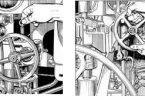Causes
When the engine is running, the air in the crankcase contains the same types of gas (NO,CO) in the same proportions as the ambient air, but there is also a heavy shower of coarse oil droplets being flung around everywhere.
If abnormal friction occurs between the sliding surfaces, or heat is otherwise transmitted to the crankcase (for instance from a scavenge air fire via the piston rod/stuffing box, or through the intermediate bottom), “Hot spots” on the heated surfaces can occur. The “hot spots” will cause the oil falling on them to evaporate.
When the oil vapour Condenses again, countless minute droplets are formed which are suspended in the air, i.e. a milky-white oil mist develops, which is able to feed and propagate a flame if ignition occurs. The ignition can be caused by the same “hot spot” which caused the oil mist.
If a large amount of oil mist has developed before ignition, the burning can cause a tremendous rise of pressure in the Crankcase (explosion), which forces a momentary opening of the relief valves. In isolated cases, when the entire crankcase has presumably been full of oil mist, the consequential explosion has blown off the Crankcase doors and set fire to the engine room.
Note: In the event that a crankcase explosion has occurred, the complete flame arrester of the relief valves must be replaced.
Every precaution should therefore be taken to:


